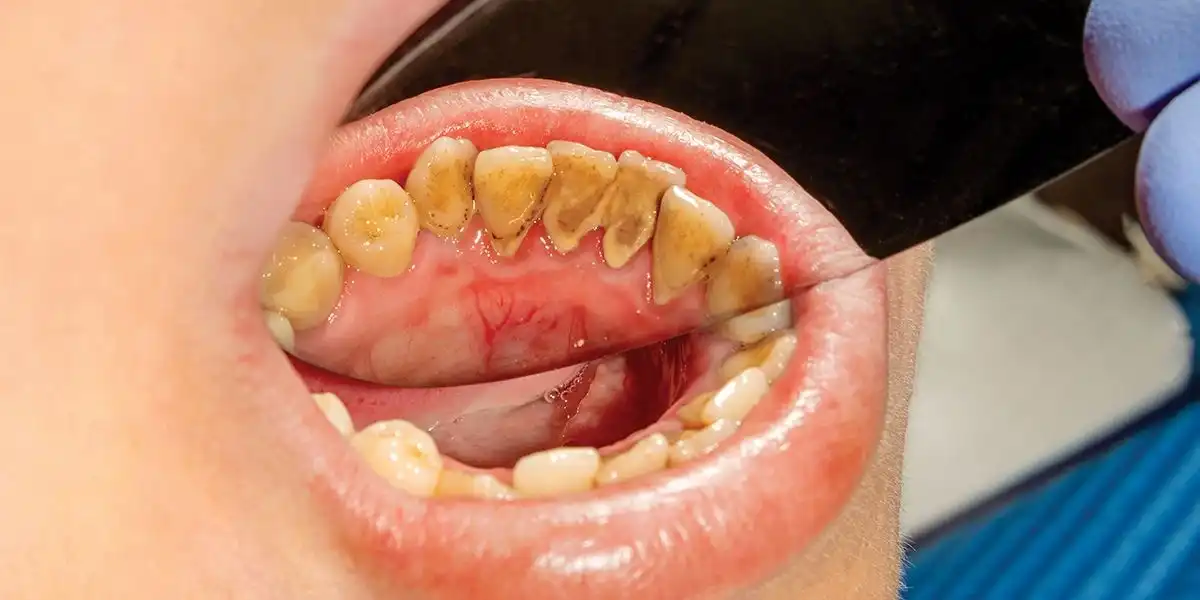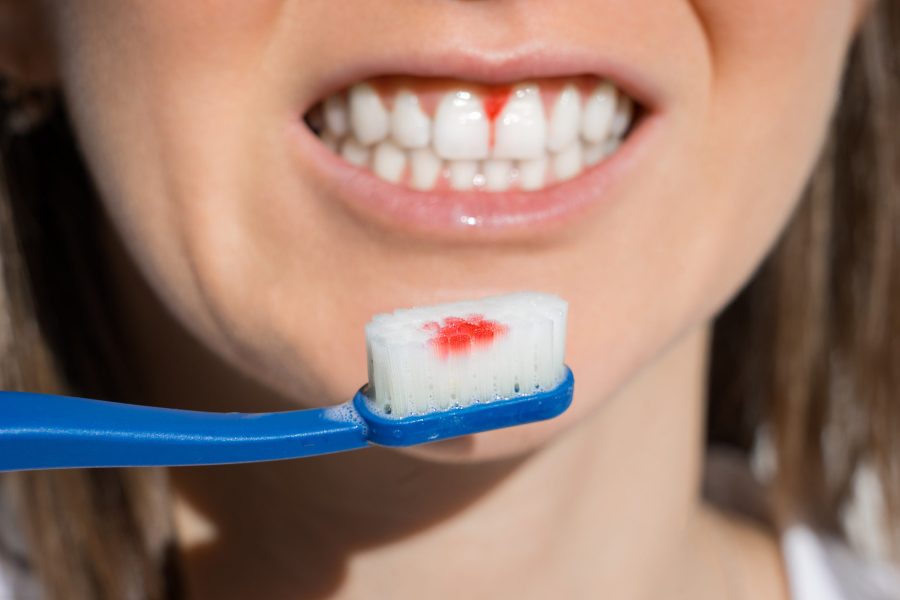
Oral health is essential to our overall health, and tartar buildup can negatively impact it. In this article, we will discuss what tartar is, why it forms, its symptoms, treatment methods, and, most importantly, ways to prevent tartar buildup.
What Is Tartar?
A tartar is a complex, yellowish or brown layer that forms on the surface of teeth. The mineralization of a bacterial layer in the mouth called plaque creates it. Plaque is a sticky layer that forms due to the accumulation of food particles and bacteria on the surface of the teeth.
If plaque is not regularly cleaned, minerals (typically calcium phosphate) accumulate within it and transform into tartar. This mineralization forms a hard layer on the teeth extending below the gumline.
Tartar often forms on the back of the teeth, the inner surfaces of the teeth, and at the junction of the gums and teeth. It can be challenging to see and clean during brushing.
Why Does Tartar Form?
The main reason for tartar buildup is a lack of regular and effective dental cleaning habits or complete neglect. Plaque forms in the mouth from a combination of bacteria, food particles, and saliva on the surface of the teeth. Plaque can be cleaned through regular brushing and flossing.
Insufficient or irregular tooth cleaning can lead to plaque accumulation and tartar formation. Failing to brush the teeth regularly, especially at night and in the morning, can accelerate plaque formation.
Difference Between Plaque and Tartar
Plaque is a sticky layer formed from the combination of bacteria, food particles, and saliva on the surface of the teeth. Plaque has a soft texture and can be easily cleaned with a toothbrush or dental floss. Tartar forms when the minerals in plaque mineralize over time. This mineralization causes the plaque layer to harden, and tartar becomes a solid structure.
Plaque can be cleaned with regular dental cleaning habits, but tartar must be removed through professional dental cleaning. Once tartar forms, a dentist must remove it from the tooth surface using special tools.
Plaque appears as a white or yellowish layer on the tooth surface and is often easily noticeable. Tartar, on the other hand, seems yellowish or brown and can be found as a distinct layer at the junction of the gums and teeth.
Tartar and plaque can lead to significant oral health problems. Plaque is a primary cause of tooth decay and gum diseases, while tartar can contribute to gum disease, tooth decay, and tooth loss.
Tartar Symptoms
Tartar may not cause noticeable symptoms, and many people may not notice its presence. Tartar often forms at the junction of the gums and teeth and is frequently found around bridges or dental implants.
Tartar can damage the gums by accumulating at the junction with the teeth. This can lead to redness, swelling, tenderness, and bleeding of the gums. Tartar forms a layer on the tooth surface, potentially facilitating tooth decay. The presence of cavities can be an indicator of tartar buildup.
Tartar symptoms are usually related to gum diseases and can be detected during regular dental check-ups. Your dentist can identify the presence of tartar and potential complications through dental exams and X-rays.
Does Tartar Cause Bad Breath?
Yes, tartar can cause bad breath due to the accumulation of bacteria. Bacteria accumulating between teeth and at the junction of the gums and teeth can lead to bad breath.
Does Tartar Cause Gum Bleeding?
Yes, tartar can cause gum bleeding. Tartar accumulates at the junction of the gums and teeth, damaging the gums. This can lead to gum disease and make the gums sensitive, swollen, and prone to bleeding.
Tartar presses against and irritates the gums, where it accumulates, leading to swelling and sensitivity. It can also cause gum inflammation, which manifests as redness, swelling, and bleeding.
As gingivitis progresses, it can lead to a more severe gum disease known as periodontitis. Periodontitis is characterized by deep inflammation of the gums and damage to the supporting tissues of the teeth.
Oral and Dental Diseases Tartar Can Cause
Tartar can lead to severe problems in oral health. Some potential diseases caused by tartar include:
Gum Diseases (Periodontal Diseases): Tartar can accumulate at the junction of the gums and teeth, damaging the gums. This can lead to gum diseases, particularly gingivitis and periodontitis.
Tooth Decay (Caries): Tartar forms a layer on the tooth surface, facilitating tooth decay. Tartar accumulation can promote bacterial growth and acid production, weaken tooth enamel, and encourage decay.
Tooth Loss: Advanced gum diseases and tooth decay are some of the main complications caused by tartar. As gum diseases progress, teeth may become loose, leading to tooth loss.
Root Decay (Tooth Root Resorption): Tartar can cause inflammation and recession of the gums surrounding the tooth roots. This can damage the bone tissue supporting the tooth roots, leading to root resorption.
Tartar-related diseases can seriously affect oral health and increase the risk of other systemic diseases. Early diagnosis and treatment are critical for protecting oral health.
Dental Treatment Methods
Various dental treatment methods can help reduce the effects of tartar and maintain oral health. Here are some of them:
Professional Dental Cleaning: A dental cleaning performed by a dentist effectively removes tartar from the tooth surface. Plaque and tartar accumulated on the teeth are cleaned using special dental tools and polished for a smooth surface.
Scaling involves cleaning tartar from the tooth surface using special dental tools. This process also cleans the gums and removes tartar accumulated below the gumline.
Root Planing: Root planing is a treatment method used in advanced cases of gum diseases. During this procedure, the surfaces of the tooth roots are smoothed and thoroughly cleaned using special tools. Root planning can stop the progression of gum disease and prevent tooth loss.
Antibacterial Mouthwash: Antibacterial mouthwash can help reduce the number of bacteria in the mouth, preventing plaque formation and tartar accumulation. Using an antibacterial mouthwash recommended by your dentist can support your oral hygiene.
Adopting regular dental cleaning habits and following your dentist’s recommendations are some of the most effective approaches to maintaining oral health.
Ways to Prevent Tartar Buildup
Preventing tartar buildup requires consistent oral hygiene habits and healthy lifestyle choices. Here are some ways to prevent tartar buildup:
Regular Tooth Brushing: Brush your teeth daily, ideally in the morning and at night. Use proper brushing techniques and pay attention to each tooth surface and gums. Use toothbrushes with appropriate bristle stiffness and replace brush heads regularly for effective cleaning.
Regular Flossing: Use dental floss to clean between teeth and the junction of the gums and teeth. This helps reduce plaque buildup in areas unreachable with brushing.
Use Mouthwash: Use antibacterial mouthwash to reduce bacteria in the mouth. This can help prevent plaque formation and tartar accumulation. However, using mouthwash should not replace brushing and flossing.
Healthy Eating Habits: Limit the consumption of sugary and starchy foods and maintain a balanced diet. Drinking enough water also supports oral health and reduces plaque buildup.
Avoid Smoking and Tobacco Use: Smoking and tobacco products can increase the risk of tartar buildup. Avoiding smoking and tobacco can help protect your oral health.
Regular Dental Check-Ups: Regular visits to the dentist help you maintain your oral health. Your dentist can evaluate your oral health, monitor tartar buildup, and recommend necessary treatments. Additionally, periodic dental X-rays recommended by your dentist can help detect underlying issues related to tartar.
Following these steps to prevent tartar buildup is essential for maintaining oral health and avoiding potential complications.




